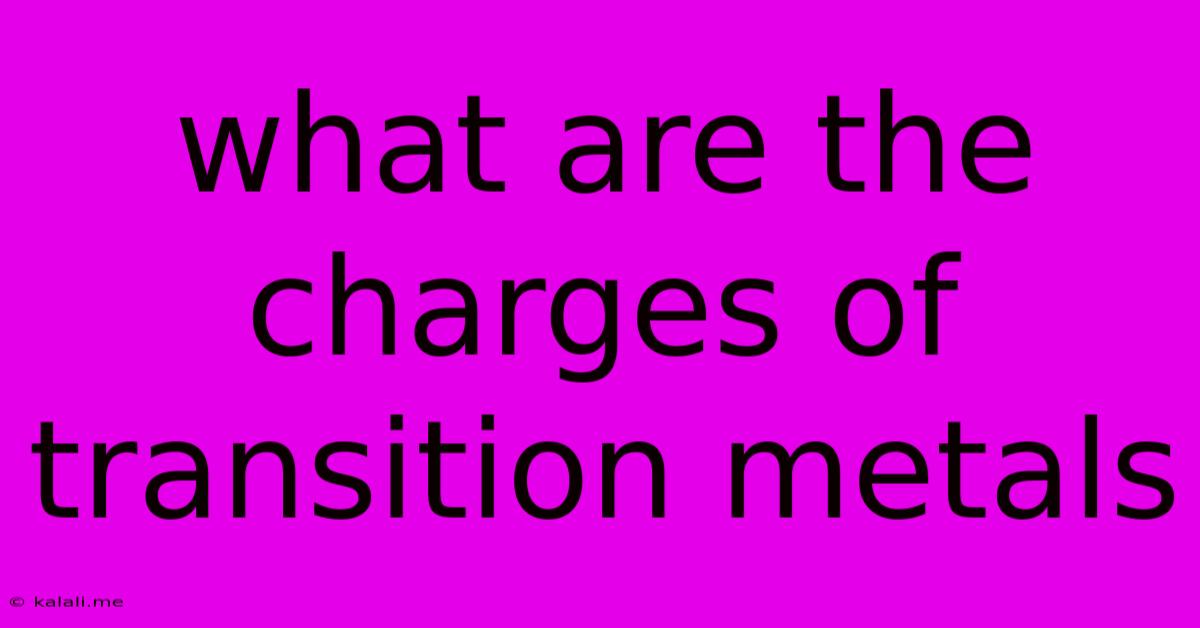What Are The Charges Of Transition Metals
Kalali
May 09, 2025 · 3 min read

Table of Contents
What are the Charges of Transition Metals? A Comprehensive Guide
Transition metals are fascinating elements known for their variable oxidation states, meaning they can exist in multiple positive charges. This characteristic is responsible for their diverse and vibrant chemistry, crucial in numerous applications from catalysis to pigmentation. Understanding the charges of these metals is fundamental to comprehending their behavior and predicting their reactions. This article will delve into the complexities of transition metal charges, exploring the factors influencing them and providing practical examples.
The Variable Nature of Transition Metal Charges:
Unlike alkali metals or alkaline earth metals which exhibit a single, predictable charge (+1 and +2 respectively), transition metals showcase a remarkable range of oxidation states. This variability stems from the involvement of both the (n-1)d and ns electrons in bonding. These electrons are relatively close in energy, making it energetically feasible for varying numbers of electrons to participate in chemical bonding, leading to different charges.
Factors Influencing Transition Metal Charges:
Several factors contribute to the diverse range of charges observed in transition metals:
-
Electronic Configuration: The specific electronic configuration of a transition metal dictates the number of electrons available for bonding. For instance, iron (Fe) can lose 2, 3, or even more electrons, resulting in charges of +2, +3, or higher.
-
Ligand Field Stabilization Energy (LFSE): This energy reflects the stabilization gained when ligands surround a metal ion. The LFSE depends on the specific ligands and the geometry of the complex, influencing which oxidation state is most stable in a given situation.
-
Oxidation Potential: The oxidation potential of a metal indicates its tendency to lose electrons and form positive ions. A higher oxidation potential suggests a greater likelihood of forming higher oxidation states.
-
Size and Electronegativity of Ligands: The size and electronegativity of the ligands bound to the metal ion can affect the stability of different oxidation states. Strong field ligands, which are highly electronegative, tend to stabilize higher oxidation states.
Common Charges and Examples:
While the range is broad, some charges are more common than others:
-
+2: This is a very common oxidation state for many transition metals, including iron (Fe²⁺), cobalt (Co²⁺), nickel (Ni²⁺), copper (Cu²⁺), and zinc (Zn²⁺). These ions are often found in various coordination complexes and inorganic salts.
-
+3: Also frequently encountered, +3 oxidation states include iron (Fe³⁺), chromium (Cr³⁺), and manganese (Mn³⁺). These ions often form highly colored compounds and are involved in many important biological processes.
-
Higher Oxidation States: Many transition metals can achieve higher oxidation states, such as +4 (e.g., manganese in MnO₂), +5 (e.g., vanadium in VO₂⁺), +6 (e.g., chromium in CrO₄²⁻), and even +7 (e.g., manganese in MnO₄⁻). These higher oxidation states often exhibit strong oxidizing properties.
Predicting Transition Metal Charges:
Predicting the exact charge a transition metal will adopt in a given compound is not always straightforward, as it depends on the interplay of several factors. However, considering the electronic configuration, the nature of the ligands, and the overall stability of the resulting complex provides a reasonable starting point.
Conclusion:
The variable charges of transition metals are a defining characteristic, driving their diverse chemistry and extensive applications. Understanding the factors influencing these charges is vital for chemists, materials scientists, and anyone working with these important elements. Further exploration into specific transition metals and their coordination complexes will reveal the intricate details of their fascinating behavior.
Latest Posts
Related Post
Thank you for visiting our website which covers about What Are The Charges Of Transition Metals . We hope the information provided has been useful to you. Feel free to contact us if you have any questions or need further assistance. See you next time and don't miss to bookmark.